Libraries are a gift. There is something magical about their existence; about the otherwise ordinary rooms and halls transformed by the books that amass on shelves and displays; a congregation of knowledge in a single space that somehow feels bigger than its physical reality. They’re places that represent more than the sum of their parts, institutions that give us the ability to travel through time and space, across universes and into worlds we’ve only dreamed of (as always, the inimitable Terry Pratchett captured this well in his concept of L-space).
Libraries were also valued by early European colonists, although perhaps not quite so whimsically. Books were relatively scarce in the colony: the expense and distance between New Zealand and European publishers made it difficult to regularly source new reading material (and, very likely, further restricted the privilege of reading to those wealthy enough to spend their time and money on books). Access to reading material was presented in the newspapers of the time as a necessity, in line with the aspirations of many settlers – particularly those involved in the civic shaping of their new society – to make Christchurch (and New Zealand) a center of education and improvement. Others expressed sentiments familiar to people in the present day (and, I suspect, throughout time): boredom and a wee bit of FOMO, hearing of the new books published in Britain and Europe, yet having to wait for months and months to read them.
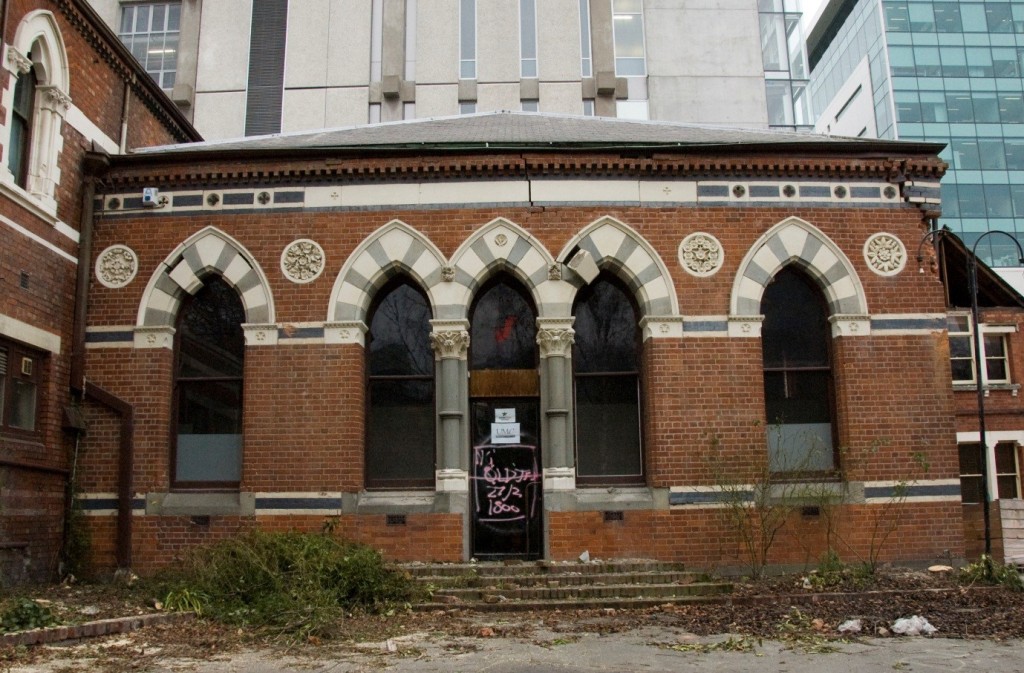
The history of the public library in Christchurch is actually a little bit complicated. The first public library established in the city had its foundations in the Christchurch Mechanics’ Institute, founded in 1859, but didn’t really exist as a public library in a way we might recognise it today until the mid-1870s, when it came under the purview of the then Canterbury College (the Christchurch City Council didn’t take it on until the 1940s – I did not know this!; Christchurch City Libraries 2020).
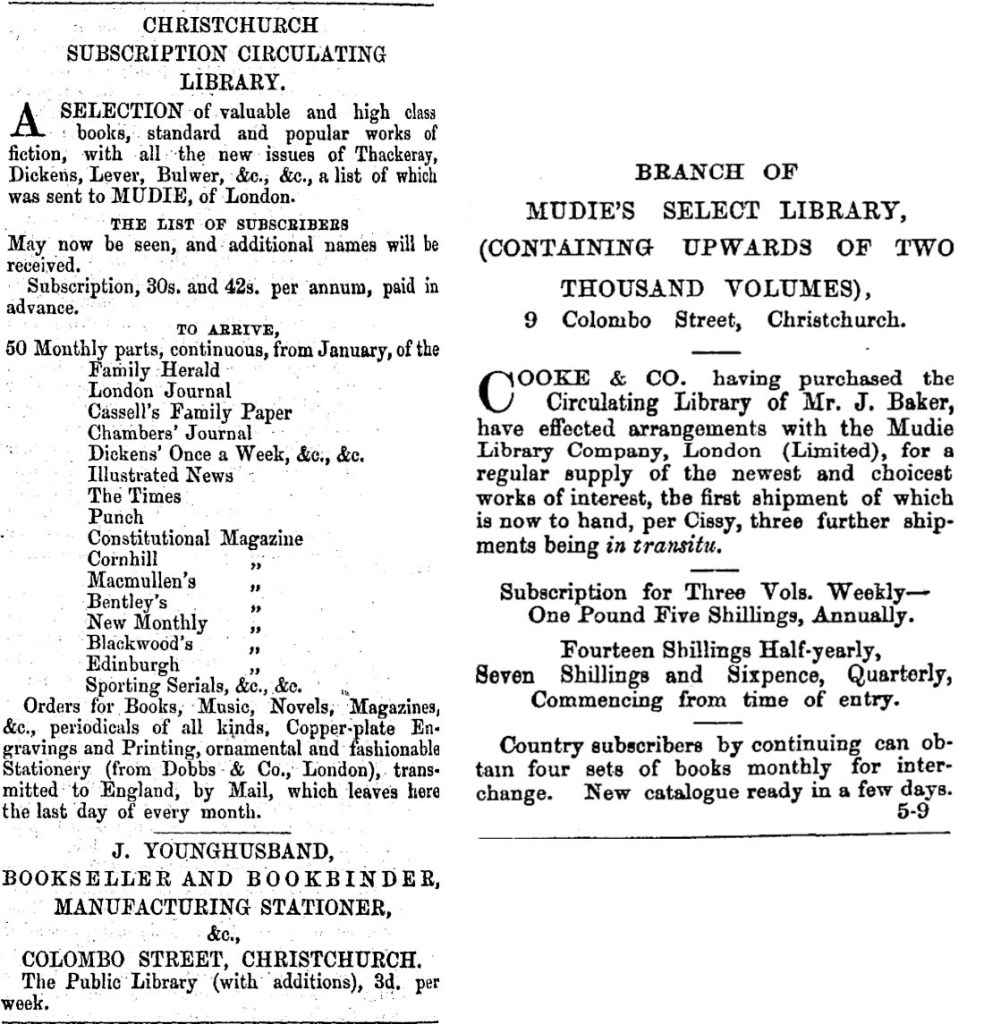
For those unfamiliar with them, mechanic’s institutes were a relatively common facet of life in the nineteenth century, founded with the intention of educating and improving the lives of their members, who were usually tradespeople, craftspeople and skilled workers (Christchurch City Libraries 2020). As with organisations like the Oddfellows, Working Men’s Associations etc., mechanic’s institutes were part of movements to improve the lot of the working classes – in this case, through lectures, public events, classes and entertainments and, most importantly, the provision of a library. This would have been contrary to the aims of the Canterbury Association, and many of the prominent early colonists, some of whom were decidedly of the opinion that education and knowledge should NOT be available for all, especially those pesky working classes (John Robert Godley had a lot to say on this and it was not good; McAloon 2000: 162). However, despite an early setback (the first attempt was not successful), the Christchurch Mechanic’s Institute was established in 1859 and the library it provided became “the most important element of the Institute’s work” (Christchurch City Libraries 2020). To that end, the Institute changed its name to The Literary Institute in 1863, when it moved from the Town Hall to a site on the corner of Cambridge Terrace and Hereford Street. By the mid-1870s, however, among financial and organizational difficulties, the library was handed over to the College and a William Armson-designed building erected next to the earlier 1863 structure on the site.
With libraries come librarians and, believe it or not, this is actually a blog about a librarian – specifically, the librarian who lived in the house next to the library on Cambridge Terrace. His name was Howard Strong and he was involved with the Christchurch Public Library from c. 1879 until his retirement in 1913, first as Sub-Librarian and then as Head Librarian from 1908 to 1913 (Christchurch City Libraries 2020). During his time with the library, he and his family lived on the premises, in a house right next door to the library building itself. There’s something to be said here about the proximity of living space to workspace, particularly in light of the evident difficulties that could be caused by living at a distance from work, as Kat mentioned in the last blog. It’s not something that we seem to concern ourselves with so much in the present day – at least not to the degree of living next door to our workplaces (if anything, there seems to be more of a desire now to separate places of work from places of living).
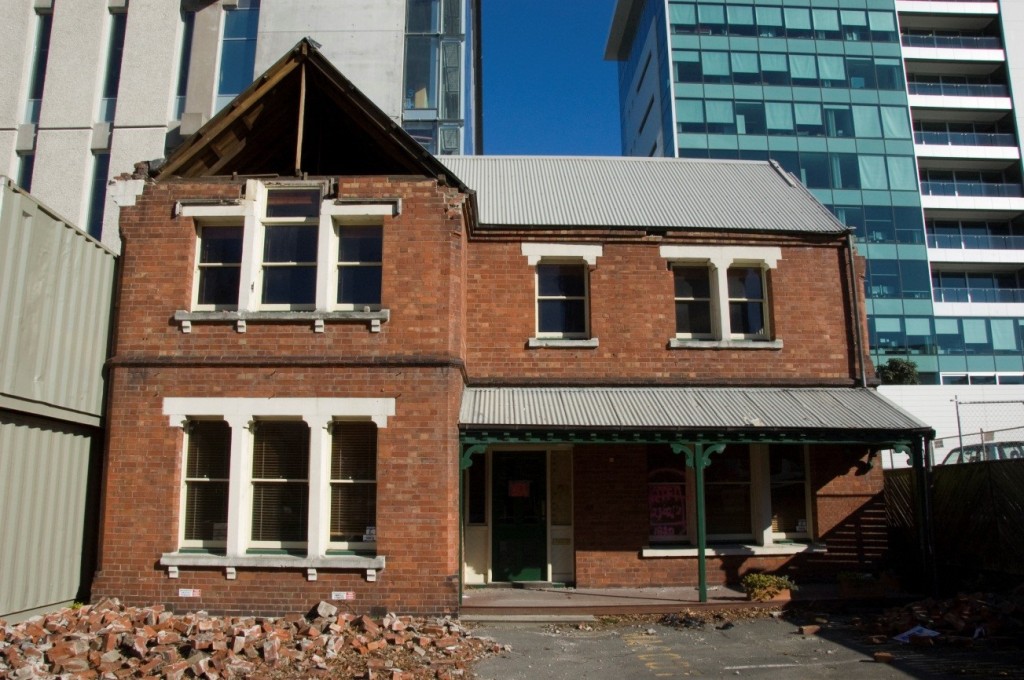
Howard was English, with a relatively interesting background, having been privately educated in England and Brussels and arriving in New Zealand at the age of 19, after three years at sea (as a sailor; he did not make the crossing to New Zealand by way of the world’s slowest moving raft; Press 24/09/1924: 11). He was very much an active participant in the colonial venture: he spent just over a decade of his life in New Zealand, prior to becoming librarian, fighting in the North Island on behalf of the colonial government and constabulary forces against local Māori. This included time as a volunteer under the command of George Whitmore during the pursuit of Te Kooti Arikirangi Te Tūruki, the Ringatū prophet and warrior, and Tītokowaru, the Ngāti Ruanui leader, military strategist and prophet. If you’ve not heard much of Te Kooti and Tītokowaru before, theirs are truly fascinating stories: both of them were men of faith, warriors and leaders, famous for their defiance of the colonial government during the 1860s and 1870s (Te Ara 2020; O’Malley 2016). If you have time, you should absolutely read more about them (I may or may not have lost a couple of hours to reading about them over the course of writing this…).
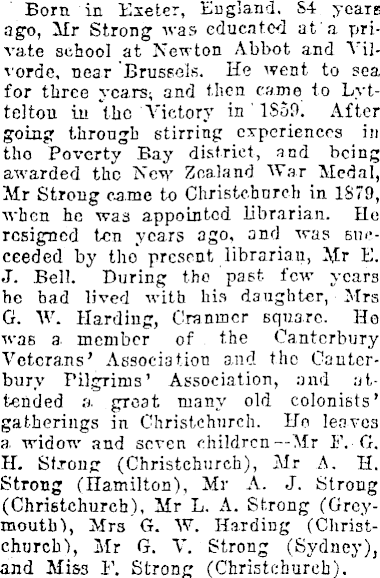
In 1875, Howard married Florence Bach, moved to Christchurch four years later and, over the course of the next little while, the couple had eight children. As is typical, there’s not a lot of existing information on Florence: her father was from Birmingham and she mostly appears in public notices and newspapers through advertisements for servants and the occasional mention in association with the library or local events. The family appear to have lived in the house next to the library from the late 1870s until 1894, when tragedy struck. A fire broke out in the house and, although Mr and Mrs Strong and seven of their children escaped injury, their 9 year old son died in the fire, which also destroyed most of the house and its furnishings. A new house (which Kat will talk about on the next post) was constructed in place of the burned building and survived through the twentieth century until the earthquakes necessitated its demolition.
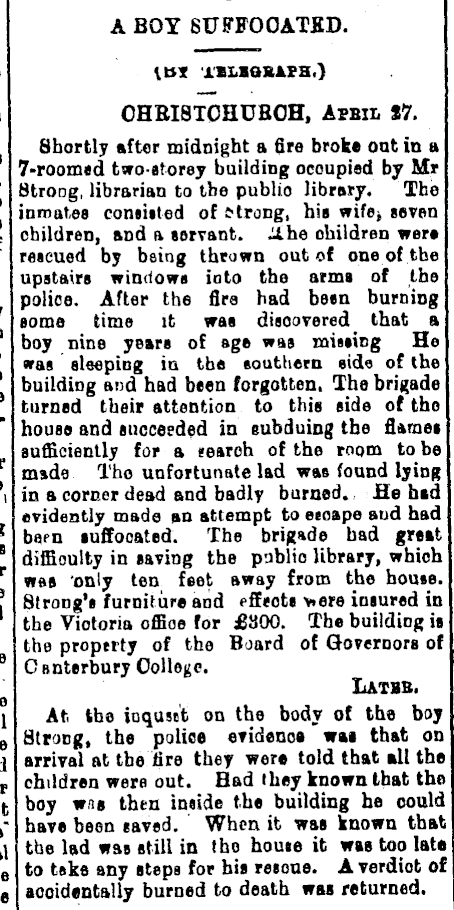
In 2012, archaeological work on the site of the librarian’s house found evidence of this fire through a burn layer beneath the foundations of the new house, very clearly associated with the events of April 1894. Mixed in with the layer was the detritus of the destroyed Strong household, through the broken and burned objects they owned at the time of the fire. The assemblage is unique in Christchurch, and unusual more generally, as we don’t often have such a clear and narrow date for the deposition of artefacts in the archaeological record. You’ll have seen that in my captions on other posts – artefacts that date to “the 1850s-1870s” or similarly vague periods of time. In this case, it’s not just that we know that the objects were disposed of in 1894, it’s that they would have been deposited as a result of the fire and so, they offer a sort of glimpse through time to the contents of the Strong household in April 1894 – or, at least, those contents that could not be salvaged after the fire (even an assemblage like this is curated by what people – the Strongs – valued enough to save or to leave; Beaudry 2005).
The assemblage contains much that is familiar and expected for a domestic household: fragments of stoneware storage jars, shards of pharmaceutical bottles, the spout from a teapot, the rim of a mixing bowl. A bottle of Bonnington’s Irish Moss may have been prescribed for colds and coughs in the household in the same way that we reach for Codral today, particularly in a household of eight children, at whom much of Bonnington’s advertising was targeted. A slate pencil may have been used and lost by one of those children in the course of their lessons (there’s little doubt that they would have been educated). Leather shoes worn by the family are evocative of the individuals who wore them.
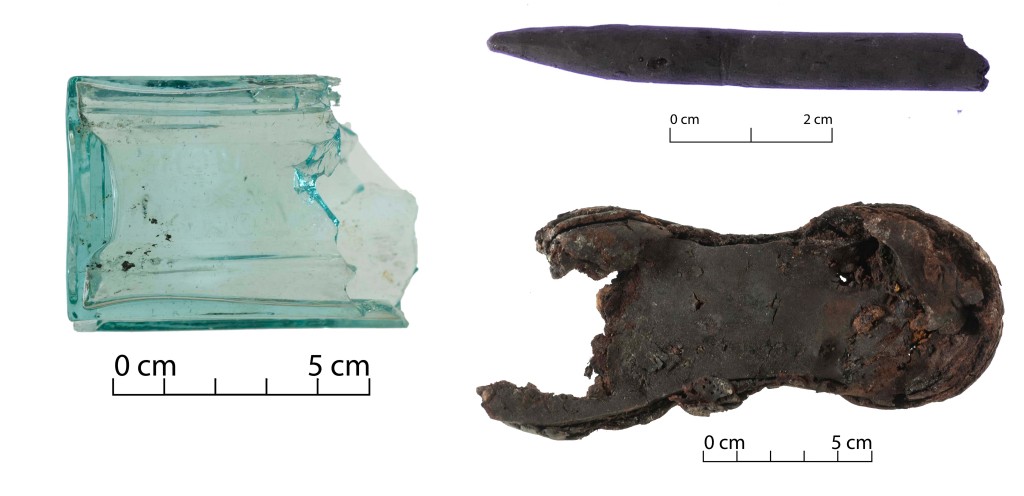
Some of the vessels were more identifiable. For example, a “porcelain” (actually glass) seal for a preserving jar, perhaps used by Florence Strong or the help she advertised for in the kitchen of the house. An agateware doorknob shows a certain attention to detail and style when it comes to the furnishings and fittings of the house. A bowl marked with the stamp of ‘F. Primavesi and Sons’ provides a link not just to the consumer choices of the Strong household, but to the mechanisms of trade and mass production in the wider world of the 1880s-1890s: Primavesi and Sons were ceramic importers and dealers in Wales and England, a sort of ‘middleman’ between the pottery factories and the retailers who sold their wares (Tolson, Gerth and Cunningham Dobson 2008).
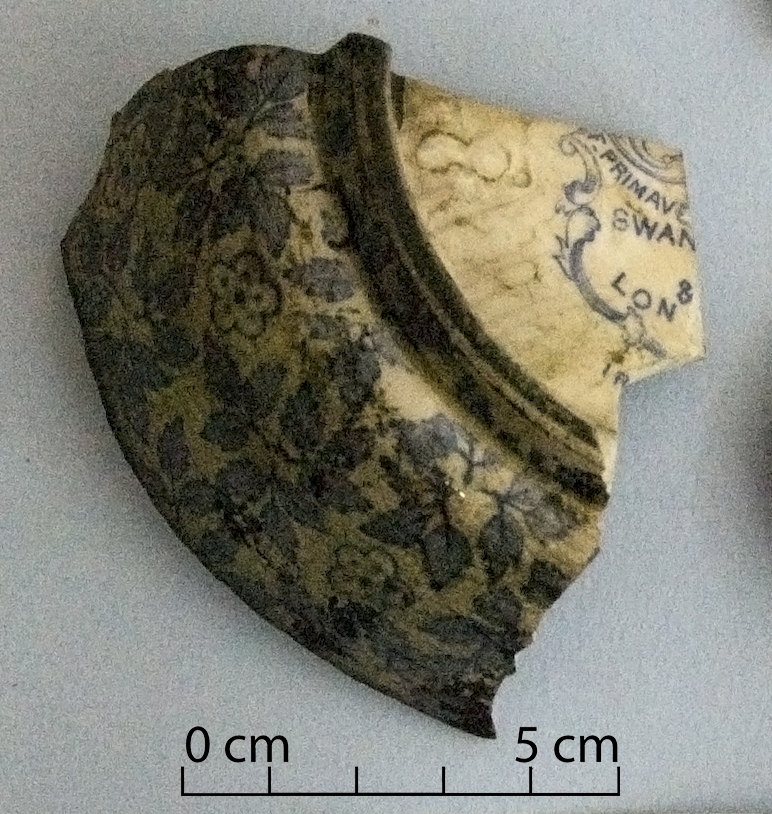

Most interestingly, perhaps, were a selection of vessels decorated with the appropriately literary “Tennyson” pattern, found in the burn layer. The effects of the fire were clear on the more than 250 fragments of this dinner set, in the melted glazes, scorched and soot-stained surfaces and the odd piece of shapeless glass fused to the pottery. That this was an assemblage of abandonment – that is, an assemblage created by circumstances that led people to abandon the goods they owned where they were left – is also reinforced by the number of different vessels from the dinner set represented in the archaeological record. Ordinarily the household waste that we create is the result of our actions and choices – the things that we break, the choice to throw out one vessel, but to repair another – and things like dinner sets may only be represented by one or two of the vessels from the set. In this case, however, it is very clear that the effects of the fire were indiscriminate (as also evident from the historic record), affecting nearly everything in the house. Consquently, the material footprint of that event provides a more comprehensive picture of the contents of an 1880s-1890s house than we might normally be able to see.
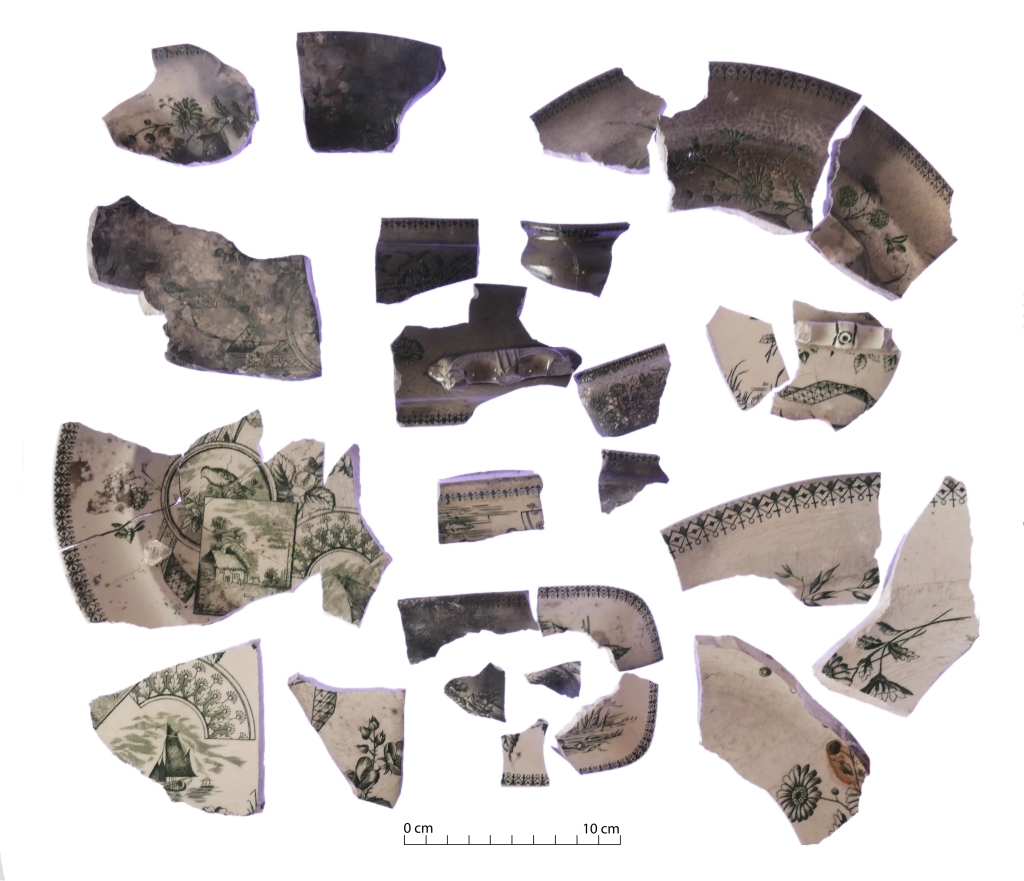
As a result, there’s also something to be said for the very clearly middle class status of the Strong household. The Tennyson dinner set is an example of aesthetic transferware, a style of ceramic decoration popular in the 1880s – it’s what has been termed a ‘high’ style of pottery, a style that changes with the fashions and trends of societies, falling in and out of vogue, in contrast to the more traditional styles – that is, the ones whose popularity remains relatively unchanged for decades – like the Willow pattern or the ever ubiquitous Asiatic Pheasants, neither of which are present in this assemblage (Majewski and Schiffer 2009). It suggests that Howard and Florence were able to keep up with the trends, so to speak, especially as one of the vessels had a mark dating its manufacture to 1888, meaning that Florence and Howard could only have owned it for six years at most. There are nods to more traditional, utilitarian styles – a Rouen plate, a banded mixing bowl – but not as many as might be expected. Instead, porcelain vessels and a matching chamber pot, wash basin and ewer set round out the ceramics from the fire (there does appear to be a certain preference for blue and green floral decoration, but whether this is representative of the time or the taste of Florence and Howard, I don’t know).
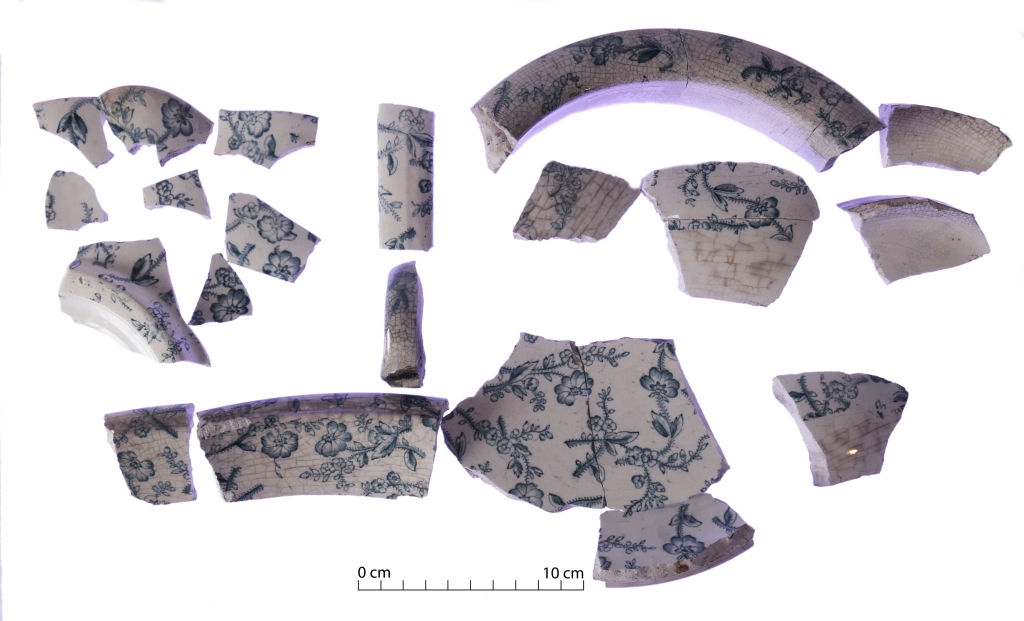
Alongside all of this, these artefacts carry the weight of their association with Howard and Florence Strong and the fire that proved so devastating to their family and to their home. They offer a glimpse into the domestic life of the librarian and his family, one that is not offered by the documentary record – we know far more about Howard Strong’s public role than we do about his household from the historical records of his life that remain. As an aside, my favourite of these is a 1908 account of a trip Howard made to Wellington to buy books from a sale – in it, he (like all good cataloguers) bemoans the disorder of the sale and discusses several of the treasured books he managed to acquire for the library. I had a look in the library catalogue and, what do you know, a handful of the books he was so happy to have bought in 1908 are still available at Tūranga in 2020, including Thomas Bewick’s A History of British Birds (1826) and Thomas Bankes’ A New Royal, Authentic and Complete System of Universal Geography, Ancient and Modern (1787-88).
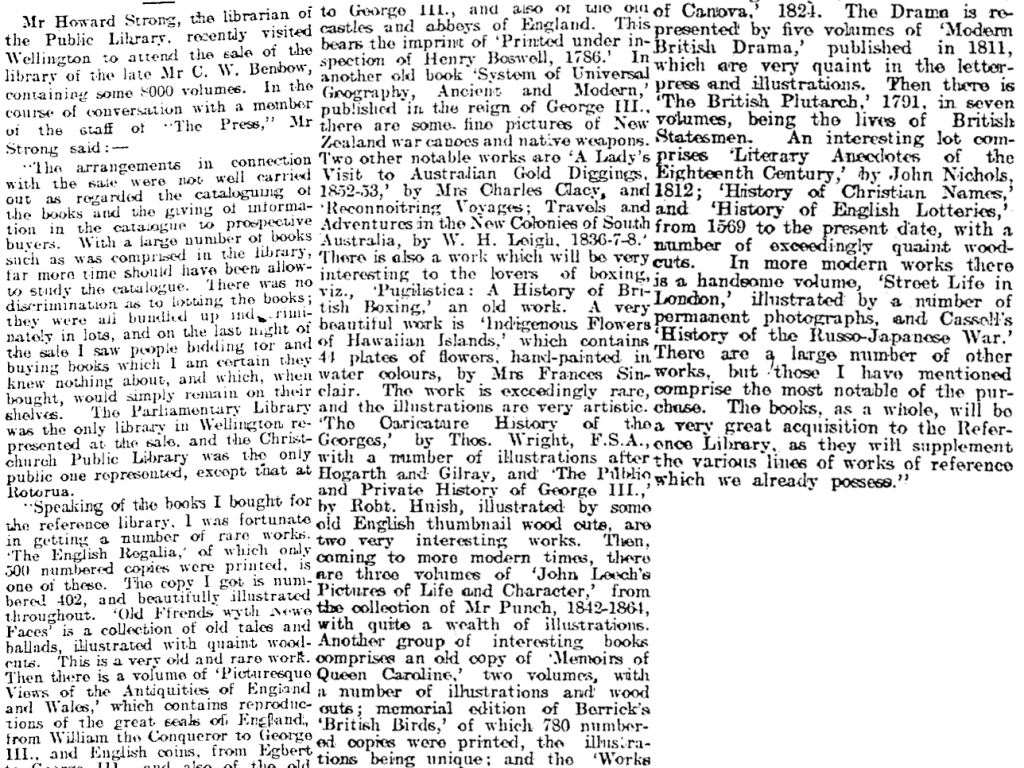
We have very little – and are likely to always have very little – in the way of material or archaeological remains of the institution of the public library in Christchurch, with the exception of those artefacts, like Thomas Banke’s geography tome or Bewick’s bird manuscript, that have remained living objects in the library system through to the present day. The artefacts from the librarians’ house, on the other hand, offer a more personal perspective on the history of the library in Christchurch, a glimpse of the people who made the institution what it was, whose actions and choices and attention protected and encouraged the growth of an establishment that remains a magical and necessary part of the Christchurch community.
Jessie
References
Beaudry, M., 2015. ‘Households beyond the House: On the Archaeology and Materiality of Historical Households’. In Fogle, K. R., Nyman, J. A. & Beaudry, M. C. (Eds), Beyond the Walls: New Perspectives on the Archaeology of Historical Households. University Press of Florida, Florida.
Christchurch City Libraries, 2020. ‘A History of Christchurch City Libraries’ [online] Available at https://my.christchurchcitylibraries.com/brief-history-christchurch-city-libraries/ [Accessed July 2020].
Christchurch City Libraries, 2020. ‘The Mechanic’s Institute’ [online] Available at https://my.christchurchcitylibraries.com/the-mechanics-institute/ [Accessed July 2020].
Christchurch City Libraries, 2020. ‘ James Nash Howard Strong, 1840-1924’ [online] Available at https://christchurchcitylibraries.com/Heritage/People/S/StrongHoward/ [Accessed July 2020].
Majewski, T. & Schiffer, M., 2009. ‘Beyond Consumption: Towards an Archaeology of Consumerism’. In Majewski, T. & Gaimster, D. (Eds), International Handbook of Historical Archaeology. Springer.
McAloon, J., 2000. ‘Radical Christchurch’. In Cookson, J. and Dunstall, G. (Eds), Southern Capital Christchurch: Towards a city biography 1850-2000. University of Canterbury.
O’Malley, V., 2016. The Great War for New Zealand: Waikato 1800-2000. Bridget Williams Books, Wellington.
Te Ara, 2020. The Encyclopedia of New Zealand. [online] Available at https://teara.govt.nz/en [Accessed July 2020].
Tolson, H., Gerth, E. and Cunningham Dobson, N., 2008. ‘Ceramics from the “Blue China” Wreck’. In Ceramics in America 2008. [online] Available at http://www.chipstone.org/issue.php/9/Ceramics-in-America-2008 [Accessed July 2020].
Watson, K., 2012. 109 Cambridge Terrace, Christchurch: Report on Archaeological Monitoring. Unpublished report for CERA.
Watson, K., 2012. 107 Cambridge Terrace, Christchurch: Report on Archaeological Monitoring. Unpublished report for Christchurch City Council.

Pingback: Of universities and architecture – The city remains
Pingback: The archaeology of uncertainty | Christchurch uncovered